UPSC Daily Current Affairs: 2 September 2024 | Current Affairs & Hindu Analysis: Daily, Weekly & Monthly PDF Download
GS2/Polity
CENSOR BOARD YET TO CLEAR KANGANA’S FILM
Source: Indian Express

Why in News?
The Central Board of Film Certification (CBFC) has not yet granted certification for the film "Emergency," which features actor and Lok Sabha member Kangana Ranaut.
- The Additional Solicitor General (ASG) indicated that the Board will consider the sentiments of various communities.
- Particularly, the Sikh community will be taken into account during the certification decision.
- During a court hearing in the Punjab and Haryana High Court, the ASG represented the Union Government and the CBFC.
- This was regarding a petition from Mohali residents contesting the film's certification.
- The ASG informed the court that the certification process is still ongoing.
- Individuals with concerns can express their opinions to the Board.
About Central Board of Film Certification (CBFC)
- The CBFC, often referred to as the Censor Board, is a statutory organization functioning under the Ministry of Information and Broadcasting in India.
- It was established according to the Cinematograph Act of 1952.
Key Functions and Responsibilities:
- Film Certification: The CBFC is responsible for certifying films, trailers, documentaries, and advertisements before they can be shown to the public in India.
Categories of Certification:
- U (Universal): Suitable for all age groups.
- UA (Parental Guidance): Appropriate for children over 12, but parental guidance is recommended for those under 12.
- A (Adult): Restricted to adults aged 18 and above.
- S (Special): Designated for specific audiences such as professionals in fields like medicine or science.
Legal Framework:
- The CBFC operates under the Cinematograph Act, 1952, which provides the regulations for film certification.
- This Act permits reasonable limitations on the freedom of speech and expression in films for reasons including national security, public order, decency, and morality.
Certification Process
- When filmmakers seek certification, a Regional Officer appoints an Examining Committee.
- For short films, the committee consists of an advisory panel member and an examining officer, with at least one member being female.
- For feature films, the committee includes four members from the advisory panel and an examining officer, with at least two female members.
- The Regional Officer determines the film's certification—U, U/A, A, or S—based on the unanimous or majority report from the Examining Committee.
- If the committee members disagree, the chairperson has the final say.
- If a filmmaker is unhappy with the certification, they can ask for a second review by a Revising Committee, which must exclude those from the initial review but must include at least one Board member.
Recent Initiatives:
- Accessibility Standards: The CBFC has implemented guidelines to enhance film accessibility for individuals with hearing and visual impairments.
- Digital Transformation: The CBFC has launched a new website and a mobile application (e-cine app) to improve the efficiency of the certification process.
GS3/Economy
ANTI-DUMPING DUTY
Source: The Hindu
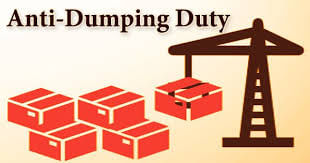
Why in News?
Directorate General of Trade Remedies (DGTR) has suggested that an anti-dumping duty be implemented on aluminium foils imported from China. This recommendation comes in response to a complaint from domestic manufacturers who claimed that the surge of inexpensive Chinese aluminium foils was detrimental to the local industry. The duty proposed is set to range from $619 to $873 per tonne.
About Anti-dumping duty
- Definition: An anti-dumping duty is a type of protectionist tariff that a domestic government enforces on foreign imports believed to be sold at prices below fair market value.
- Impact of Dumping: This practice, referred to as “dumping,” can negatively affect domestic industries by undermining local businesses and creating imbalances in market competition.
- Role of DGTR: The Directorate General of Trade Remedies (DGTR), which operates under the Ministry of Commerce and Industry, is tasked with the investigation and recommendation of anti-dumping duties in India.
Decision-Making Process:
- Investigation: The DGTR initiates an inquiry to ascertain whether dumping has occurred and evaluates its effects on the domestic industry.
- Recommendation: Following the investigation, the DGTR makes its recommendations to the Ministry of Finance regarding the imposition of duties.
- Imposition: The final decision on whether to implement the anti-dumping duty rests with the Ministry of Finance.
Purpose of imposing anti-dumping duties in India:
- Protecting Domestic Industries: Anti-dumping duties serve to shield local industries from unfair competition, preventing foreign entities from saturating the market with underpriced products.
- Preserving Jobs: By protecting domestic sectors from the detrimental effects of dumping, these duties help avert job losses that could arise if local firms struggle to compete against cheaper imports.
- Maintaining Fair Competition: These duties encourage fair competition by ensuring that imported goods are priced in line with their fair market value, thus preventing foreign companies from securing an unfair edge.
- Supporting Fair Trade Practices: The enforcement of anti-dumping duties deters unethical trading activities such as predatory pricing and dumping. By penalizing these practices, it promotes adherence to fair trade principles and curbs market manipulation.
- Protecting Intellectual Property: Anti-dumping duties can contribute to the safeguarding of intellectual property rights by discouraging the influx of counterfeit or infringing products. This helps protect the interests of innovators and creators by reducing the availability of low-priced counterfeit items.
- Stimulating Domestic Production: By mitigating the competitive disadvantage faced by local manufacturers, anti-dumping duties can encourage domestic production.
- Promoting Economic Stability: These duties help maintain economic stability and resilience by protecting domestic industries and preserving jobs, thereby supporting sustainable growth and development in the long run.
GS1/Geography
LA NINA
Source: The Hindu
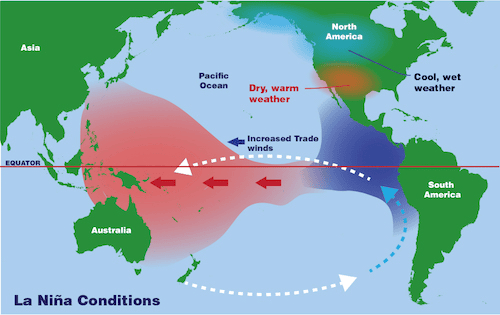
Why in news?
India Meteorological Department (IMD) has forecasted a rainy September for several parts of north India due to the expected La Niña conditions.
About La Niña
- La Niña is a climatic phenomenon characterized by the cooling of sea surface temperatures in the central and eastern tropical Pacific Ocean.
- This event is a significant component of the El Niño-Southern Oscillation (ENSO) cycle, which also encompasses El Niño (the warming phase) and a neutral phase.
- Key features of La Niña:
- Cooler Ocean Temperatures: The central and eastern Pacific Ocean experiences sea surface temperatures that are cooler than average.
- Weather Impacts: La Niña usually results in wetter conditions in Southeast Asia, Australia, and certain regions of India, while causing drier weather in the southwestern United States and parts of South America.
- Monsoon Influence: In India, La Niña is frequently associated with enhanced monsoon seasons, resulting in above-average rainfall.
- Global Effects: This phenomenon can alter global weather patterns, including an increase in hurricane activity in the Atlantic and cooler, wetter winters across the northern United States.
Effects of La Niña on India
- Enhanced Monsoon Rains: La Niña typically leads to increased rainfall during the monsoon season (June to September), which is advantageous for agriculture due to improved water availability.
- Flooding Risks: Although extra rainfall can be beneficial, it also heightens the risk of flooding, especially in low-lying areas and regions with inadequate drainage systems.
- Agricultural Productivity: The surplus rainfall is likely to enhance crop yields for rain-fed crops such as rice, sugarcane, and pulses. However, excessive rain may also damage crops and cause waterlogging.
- Water Resources: La Niña can elevate water levels in reservoirs, rivers, and groundwater, which is vital for irrigation and drinking water supplies.
- Temperature Variations: La Niña may result in cooler-than-normal temperatures in certain parts of India, particularly during the winter months.
- Pest and Disease Outbreaks: The increased moisture can foster an environment conducive to pests and diseases, which may harm crops and reduce overall yields.
GS2/Polity
Rights of the accused in PMLA cases and recent SC Verdicts
Source: Economic Times

Why in news?
The Supreme Court in Vijay Madanlal Choudhary v. Union of India (2022) upheld several provisions of the Prevention of Money Laundering Act (PMLA), confirming the Enforcement Directorate's (ED) extensive powers in investigating and arresting those accused of money laundering. This ruling supported strict bail conditions under the PMLA, reinforcing the Act's strong framework against money laundering. However, the Supreme Court has also made minor adjustments that gradually moderate some stringent provisions, balancing the need for rigorous anti-money laundering measures with the protection of individual rights, particularly regarding arrest and bail. This reflects the Court's ongoing efforts to ensure that PMLA enforcement does not encroach on the fundamental rights of the accused.
Various relaxations extended by the Supreme Court to the PMLA Accused
- On grounds of arrest
- Section 19 of the PMLA empowers the ED to arrest individuals if they have reason to believe an individual is guilty of money laundering.
- The accused must be informed of the grounds for their arrest as soon as possible.
- The Supreme Court ruled that the ED does not need to provide a copy of the Enforcement Case Information Report (similar to an FIR) to the accused, only the reasons for the arrest.
- In Pankaj Bansal v. Union of India (2023), the Supreme Court emphasized that the accused have a fundamental right under Article 20 of the Constitution to be informed of the grounds of their arrest.
- The Court noted that the grounds were sometimes given orally or in writing and clarified that the grounds of arrest must always be provided in writing. Failure to do so would render the arrest illegal.
- This ruling highlights the importance of protecting the rights of the accused while enforcing the law.
- On bail for undertrials
- Section 436A of the Code of Criminal Procedure (CrPC) allows for bail release of individuals detained for up to half the maximum period of imprisonment while their trial or investigation is ongoing.
- The Supreme Court extended this provision to apply to PMLA cases in Vijay Madanlal Choudhary v. Union of India (2022).
- This interpretation was reaffirmed in May 2024 in Ajay Ajit Peter Kerkar v. Directorate of Enforcement.
- Section 436A has been replaced by Section 479 of the Bharatiya Nagarik Suraksha Sanhita, which may affect PMLA cases.
- A new explanation excludes the application of the bail provision if multiple cases are pending against the accused, a common scenario in money laundering cases.
- This amendment potentially limits the benefit of bail under the PMLA, making it more challenging for accused individuals to secure release.
- However, in August 2024, the Supreme Court reiterated that the legal principle "bail is the rule and jail is the exception" will apply even in PMLA cases.
- On ‘need and necessity to arrest’
- In July 2024, the Supreme Court granted interim bail to Delhi CM Arvind Kejriwal in the Delhi excise policy case, challenging the legality of his arrest under Section 19 of the PMLA.
- Kejriwal argued that there was no "necessity" for his arrest, asserting that the material used by the ED for the arrest was available earlier.
- Section 19(1) requires the ED to have sufficient reason to believe that the accused is guilty, which the Court noted must meet a high threshold based on admissible evidence.
- The Supreme Court referred the question of whether "need and necessity to arrest" can be a valid ground for challenging an arrest under the PMLA to a five-judge bench for further consideration.
- This referral indicates the Court's intention to scrutinize the conditions under which arrests are made under the PMLA, potentially influencing future interpretations of the law.
- On relaxing twin conditions
- In August 2024, the Supreme Court granted bail to former Delhi Deputy Chief Minister Manish Sisodia in the Delhi excise policy case.
- Under Section 45 of the PMLA, the twin conditions for bail are strict: the accused must prove they did not commit an offense under the PMLA and are unlikely to do so while on bail.
- This effectively reverses the standard burden of proof in criminal cases.
- However, the bench ruled that these conditions could be relaxed if the accused has been incarcerated for a long period without trial proceedings starting.
- In Sisodia's instance, he had been imprisoned for approximately 17 months without the trial beginning, highlighting the Court's recognition of prolonged pre-trial detention as a valid reason to relax stringent bail conditions.
- On bail exception for women
- In August 2024, the Supreme Court granted bail to BRS leader K Kavitha in the Delhi excise policy case, citing the exception in Section 45 of the PMLA that allows for women's bail if the Special Court so directs.
- The Supreme Court overturned the Delhi High Court's earlier decision to deny Kavitha bail, where the High Court argued that her education disqualified her as a "vulnerable woman."
- This ruling reaffirms that the Section 45 exception applies to women regardless of their educational background, ensuring a consistent interpretation of the provision's intent.
- On confession to ED officer
- Section 50 of the PMLA allows the ED to summon individuals and require them to make statements during investigations.
- In Vijay Madanlal Choudhary v. Union of India (2022), the SC ruled this provision does not violate the right against self-incrimination under Article 20(3) of the Constitution.
- However, Section 25 of the Evidence Act, 1872 (now Section 23 of the Bharatiya Sakshya Adhiniyam, 2023), states that confessions made to police officers are inadmissible in trial.
- In Prem Prakash v. Union of India (2024), the SC noted that a person in custody cannot be seen as operating with a free mind, suggesting they may be under duress or coercion.
- Past judgments confirmed that evidence gained through compelled testimony violates the right against self-incrimination.
- This reasoning emphasizes that confessions made while in custody, especially if coerced, are inadmissible as evidence, reinforcing protections against self-incrimination.
GS3/Environment
 |
Daily Current Affairs MCQ: 30th September 2024
|
Start Test |
2G BIO-ETHANOL
Source: The Hindu

Why in news?
The Indian government is initiating the establishment of specialized enzyme manufacturing facilities aimed at enhancing ethanol production. The inaugural plant is anticipated to be set up in Manesar, Haryana, which will cater to the enzyme requirements of proposed 2G bio-ethanol plants located in Uttar Pradesh, Punjab, and an existing facility in Haryana. This initiative is part of the BioE3 policy, which seeks to promote biotechnology-driven manufacturing in India.
About 2G (second-generation) bio-ethanol
- 2G bio-ethanol is derived from non-food biomass sources, such as agricultural waste, wood chips, and other lignocellulosic materials.
- In contrast to first-generation bio-ethanol, which is produced from food crops like corn and sugarcane, 2G bio-ethanol utilizes feedstocks that do not compete with the human food supply, making it a more sustainable option.
- The production process involves deconstructing complex carbohydrates found in biomass into simpler sugars, which are then fermented to yield ethanol. This process relies on specific enzymes to convert lignocellulosic materials into fermentable sugars.
Key benefits of 2G bio-ethanol:
- Reduces waste by utilizing agricultural residues that would otherwise be discarded or incinerated.
- Lower greenhouse gas emissions, as it produces significantly fewer emissions compared to fossil fuels and first-generation bio-ethanol.
- Enhances energy security by decreasing reliance on imported fossil fuels and providing a renewable energy alternative.
Ethanol
- Ethanol, also referred to as ethyl alcohol, is a transparent, colorless liquid known for its flammability and distinct odor.
- This substance is generated through the fermentation of sugars by yeast or via chemical methods such as the hydration of ethylene.
- Ethanol can originate from both biological and chemical processes, whereas bioethanol is solely produced from biological sources.
Uses of Ethanol
- Beverages: Ethanol is the primary alcohol present in alcoholic drinks like beer, wine, and spirits.
- Fuel: It is utilized as a biofuel, commonly blended with gasoline to create ethanol-blended fuels, which aids in reducing greenhouse gas emissions and dependence on fossil fuels.
- Industrial Solvent: Ethanol's ability to dissolve a wide variety of substances makes it a valuable solvent in the production of pharmaceuticals, perfumes, and more.
- Medical and Laboratory Uses: It serves as an antiseptic, disinfectant, and preservative in both medical and laboratory environments.
- Chemical Feedstock: Ethanol is used as a raw material for the synthesis of various chemicals.
GS2/Governance
RETIRED SPORTSPERSON EMPOWERMENT TRAINING (RESET) PROGRAMME
Source: AIR

Why in News?
Union Minister of Youth Affairs & Sports and Labour & Employment, Dr. Mansukh Mandaviya recently inaugurated the "Retired Sportsperson Empowerment Training" (RESET) Programme. This initiative marks a pivotal advancement in acknowledging and leveraging the vast experience and skills of retired athletes.
About Retired Sportsperson Empowerment Training (RESET) Programme:
- The RESET Programme is a new initiative introduced by the Ministry of Youth Affairs & Sports in India, aimed at providing support to retired athletes.
- Launch Date: The programme was officially launched on August 29, 2024, coinciding with National Sports Day.
- Objective: The primary goal is to empower retired sportspersons by equipping them with career skills and knowledge, thereby boosting their employability and enabling them to make meaningful contributions to the sports ecosystem.
Eligibility Criteria:
- Age Group: The programme is open to retired athletes aged between 20 and 50 years.
- Achievements: Eligibility extends to individuals who have won international medals, participated in international competitions, or have been national or state medallists in events recognized by the National Sports Federations, the Indian Olympic Association, or the Ministry of Youth Affairs and Sports.
- Educational Levels: The courses under the RESET Programme are categorized into two levels based on educational qualifications: Class 12 and above, and Class 11 and below.
Mode of Learning:
- The programme will be delivered through a hybrid model, combining self-paced online learning with practical on-ground training.
- Lead Institute: The Lakshmibai National Institute of Physical Education (LNIPE) has been designated as the lead institute responsible for implementing the RESET Programme.
Support and Opportunities:
- Placement Assistance: Participants will receive guidance and support for job placements in various sectors.
- Entrepreneurial Guidance: The programme will also provide resources and advice for those interested in starting their own ventures.
- Internships: There will be opportunities for internships within sports organizations, competitions, training camps, and leagues to gain practical experience.
Implementation and Benefits:
- Self-Paced Learning: Participants will have the flexibility to learn at their own pace via a dedicated online portal.
- On-Ground Training: The programme includes practical training sessions designed to enhance participants' skills.
- Evaluation and Certification: Upon successful completion of the programme, participants will undergo evaluation and receive certification.
GS2/International Relations
Why are More Undocumented Indian Immigrants Entering the US on Foot
Source: Indian Express
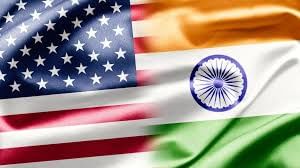
Why in News?
According to recent statistics from the U.S. Customs and Border Protection, there has been a remarkable rise in the number of undocumented Indian immigrants entering the U.S. on foot.
Data on Undocumented Indian Immigration to US
- In the fiscal year 2022-23, 96,917 Indians entered the U.S. without proper documentation.
- This represents a fivefold increase from FY 2019-20, when only 19,883 Indians crossed the border without papers.
- Out of nearly 97,000 encounters in FY 2022-23, 30,010 occurred at the Canadian border, while 41,770 were at the Southern border.
Factors Responsible for the Undocumented Indian Immigration to US
- Overall growth in global migration since the pandemic:
- The number of undocumented Indians in the U.S. has risen since borders reopened post-Covid, with 30,662 encounters in FY 2021 and 63,927 in FY 2022.
- Unregulated travel agencies in India:
- Social media has facilitated the emergence of travel agencies, where hopeful migrants often invest their life savings for the journey.
- Smugglers using increasingly sophisticated routes:
- These routes extend from the Middle East through Europe and Africa/South America, finally reaching northern Mexico before crossing into the U.S.
- Extreme visa backlogs:
- Individuals may prefer to reach the Southern border rather than wait for a visitor visa in Delhi.
- Unguarded Canadian border:
- Canada presents an accessible visa process and a relatively soft border, making it a safer option compared to illegal routes through West Asia, Africa, or the Caribbean.
Push and Pull Factors
- Push factors:
- Oppression of minority communities in India has led to increased migration.
- The recent rise may be influenced by deteriorating conditions for minorities such as Muslims, Sikhs, and Christians in India.
- The farmers' protests in 2020 against agricultural deregulation have resulted in a surge in asylum claims.
- Pull factors:
- The successful experiences of Indian Americans and previous migrants often entice new individuals to undertake the journey.
- Long-standing visa backlogs hinder many from joining their families in the U.S., leaving them with little choice but to migrate illegally.
GS3/Science and Technology
VANDE BHARAT TRAINS
Source: Indian Express
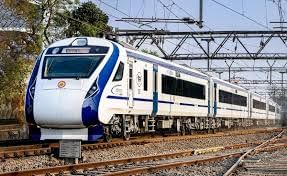
Why in news?
Prime Minister flags off 3 Vande Bharat trains.
Background:
- The recently inaugurated trains connect Meerut with Lucknow, Madurai with Bengaluru, and Chennai with Nagercoil, bringing the total number of Vande Bharat trains to over 100.
Key takeaways:
- The Vande Bharat Express, also referred to as Train 18, represents a major initiative by Indian Railways aimed at enhancing and modernizing rail travel across the country.
- The inaugural Vande Bharat Express was introduced in 2019, marking the beginning of a new era in Indian rail transport.
- This train service is specifically designed to deliver a travel experience that is high-speed, comfortable, and efficient.
Features:
- Speed: Capable of reaching speeds up to 180 km/h, the train usually operates around 130 km/h due to existing track conditions.
- Design: The trains boast a sleek and aerodynamic structure and come with fully air-conditioned chair car coaches. Plans are underway to introduce sleeper coaches in the future.
- The Integral Coach Factory (ICF) in Chennai is responsible for the design and manufacture of the Vande Bharat Express trainsets. ICF holds the title of the world's largest rail coach manufacturer and is operated by Indian Railways.
- Comfort: Passengers can enjoy modern conveniences such as onboard Wi-Fi, GPS-based passenger information systems, and bio-vacuum toilets, enhancing the travel experience.
- Self-Propelled Technology: Unlike traditional trains that rely on a separate locomotive, the Vande Bharat Express features a self-propelled system known as distributed traction. This innovation allows for quicker acceleration and deceleration, enabling the train to reach its maximum speed more efficiently.
- Energy Efficiency: The trains are outfitted with regenerative braking systems, which recycle kinetic energy generated during braking and convert it into electrical energy, promoting energy conservation.
GS2/Polity
 |
Download the notes
UPSC Daily Current Affairs: 2 September 2024
|
Download as PDF |
Rule 170 of Drugs Act
Source: Indian Express
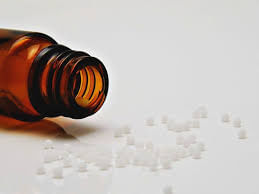
Why in News?
In the ongoing Supreme Court case against Patanjali Ayurved, Justices Hima Kohli and Sandeep Mehta criticized and stayed the AYUSH ministry for its July 1 notification. The notification directed state licensing authorities not to take any action under Rule 170 of the Drugs and Cosmetics Act.
About
The Drugs and Cosmetics Act oversees the import, production, and distribution of drugs in India. Its main goal is to ensure that the drugs and cosmetics available in the country are reliable, effective, and meet national standards. The associated Drugs and Cosmetics Rules, 1945, were formulated in conjunction with the 1940 Act, providing guidelines for classifying medications and instructions for their storage, sale, presentation, and prescription.
Key provisions
- Licensing: The Act requires all manufacturers and sellers of drugs and cosmetics to obtain licenses from the drug control authorities.
- Standards and Testing: It establishes quality standards for drugs and cosmetics and mandates rigorous testing to ensure compliance.
- Approval Process: The Act details the approval process for new drugs, including clinical trials and safety evaluations.
- Regulation of Advertisements: It governs the advertising of drugs and cosmetics to prevent misleading claims and ensure accurate information is provided to consumers.
- Penalties: The Act stipulates penalties for violations, including the manufacturing or selling of substandard or misbranded drugs and cosmetics.
Background – why rule 170 was introduced
Rule 170 was implemented in response to concerns raised by a parliamentary standing committee regarding misleading claims in AYUSH product advertisements, necessitating stricter oversight by the AYUSH ministry.
Key features
- In 2018, the Indian government enacted Rule 170 under the Drugs and Cosmetics Act to regulate the manufacture, storage, and sale of Ayurvedic, Siddha, and Unani medicines, focusing on curbing misleading advertisements.
- This rule prohibits AYUSH drug manufacturers from advertising their products without prior approval and requires the issuance of a unique identification number by the state licensing authority.
- Manufacturers must provide detailed information, including references, rationale, safety, effectiveness, and quality of the drugs.
- Applications can be rejected if:
- Contact details are missing
- The advertisement is obscene or vulgar
- It promotes sexual enhancement
- It features celebrities or government officials
- It references government organizations or makes false or exaggerated claims
Challenges to regulate AYUSH drugs
Under the Drugs and Cosmetics Act, AYUSH drug manufacturers are required to obtain licenses similar to allopathic drug manufacturers. However, unlike allopathic drugs, which must undergo extensive phase I, II, and III trials or equivalence studies before approval, most AYUSH drugs can be approved based on the rationale provided in authoritative texts. Safety trials are only mandated for formulations containing around 60 specific ingredients listed in the act, such as snake venom, heavy metals like arsenic and mercury, and compounds like copper sulfate. Proof of effectiveness is also necessary for drugs containing these ingredients or traditional drugs being used for new indications.
Notification issued by the AYUSH Ministry
In a contempt case against Patanjali Ayurved Limited, the Supreme Court (in May 2024) directed that advertisers must submit self-declarations confirming they are not misrepresenting or making false claims about products before media promotion. However, the AYUSH Ministry (on July 1, 2024) notified that Rule 170 of the Drugs and Cosmetics Rules, 1945, was no longer operational.
Why did the AYUSH ministry direct licensing authorities to ignore the rule?
In May 2023, the Ayurvedic, Siddha, and Unani Drugs Technical Advisory Board (ASUDTAB) recommended that Rule 170 be omitted. ASUDTAB is an expert body that advises on the regulation of AYUSH drugs. This recommendation was made due to amendments being made to the Drugs and Magic Remedies Act, 1954, which also regulates misleading advertisements of AYUSH drugs. In this context, the AYUSH ministry suggested ignoring Rule 170, as other legislative changes would address similar issues.
GS2/Polity
Is the Administration of Lie-Detector Tests Legally Valid?
Source: The Hindu
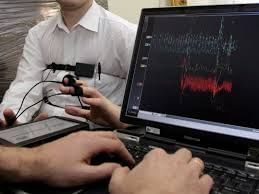
Why in news?
The Central Bureau of Investigation (CBI) recently carried out a second round of polygraph tests on several individuals connected to the rape and murder of a doctor at R.G. Kar Medical College and Hospital in Kolkata. These tests were conducted after one of the suspects provided inconsistent responses during questioning.
What are Deception Detection Tests (DDTs)?
- Deception Detection Tests are scientific methods employed during interrogations to identify lies.
- Types of DDTs include:
- Polygraph Tests: These tests assess physiological responses such as blood pressure, pulse rate, and skin conductivity to determine if an individual is lying.
- Narco-Analysis: This involves inducing a drug-induced state where the subject is believed to be less capable of deception. Sodium pentothal is administered to the accused.
- Brain Mapping: This technique evaluates brain activity to detect recognition of familiar stimuli, which can suggest deception.
Effectiveness of DDTs:
- The effectiveness of DDTs is a subject of significant debate within the medical community.
- A 2010 study published in the Indian Journal of Medical Research noted that lie detection methods face heavy criticism, and their ability to reveal “concealed knowledge in real-world scenarios” remains questionable.
- Similarly, a 2019 study in the United States highlighted the high false positive rates of polygraph tests and noted that individuals can be trained to manipulate the results.
Judicial Precedents on Lie-Detector Tests:
- Prior to 2010, Indian courts generally supported the use of DDTs in investigations without requiring consent from the accused.
- However, in the landmark case of Selvi v. State of Karnataka (2010), the Supreme Court ruled that such tests could only be conducted with the accused's consent, emphasizing the right against self-incrimination under Article 20(3) of the Constitution.
- Article 20(3) states that no person accused of an offense can be forced to provide evidence or testimony that could implicate themselves.
- The Court further mandated that individuals who volunteer for these tests must have access to legal counsel and be informed about the physical, emotional, and legal consequences of undergoing the test.
- Additionally, the subject's consent must be formally documented before a judicial magistrate, and the guidelines established by the National Human Rights Commission in 2000 for administering these tests must be strictly followed.
Existing Concerns:
- Despite the Supreme Court's guidelines, the use of DDTs persists in India, especially in high-profile cases.
- There are serious concerns regarding the coercive nature of these tests and the risk of misuse, including the extraction of false confessions under pressure.
- Critics argue that these tests lack scientific reliability, and the refusal to undergo such tests is often inappropriately used to imply guilt.
Conclusion:
- The administration of lie-detector tests in India is a contentious issue, balancing the need for effective investigations with the protection of individual rights.
- While the Supreme Court has imposed stringent guidelines for their use, the ethical and scientific legitimacy of these tests continues to be a topic of debate.
|
39 videos|4566 docs|979 tests
|
FAQs on UPSC Daily Current Affairs: 2 September 2024 - Current Affairs & Hindu Analysis: Daily, Weekly & Monthly
| 1. Why has the censor board not yet cleared Kangana's film? |  |
| 2. What is the significance of the Anti-Dumping Duty? |  |
| 3. What is La Nina and how does it impact weather patterns? |  |
| 4. What are the rights of the accused in PMLA cases according to recent SC verdicts? |  |
| 5. How does the RETIRED SPORTSPERSON EMPOWERMENT TRAINING (RESET) PROGRAMME aim to empower retired athletes? |  |

































